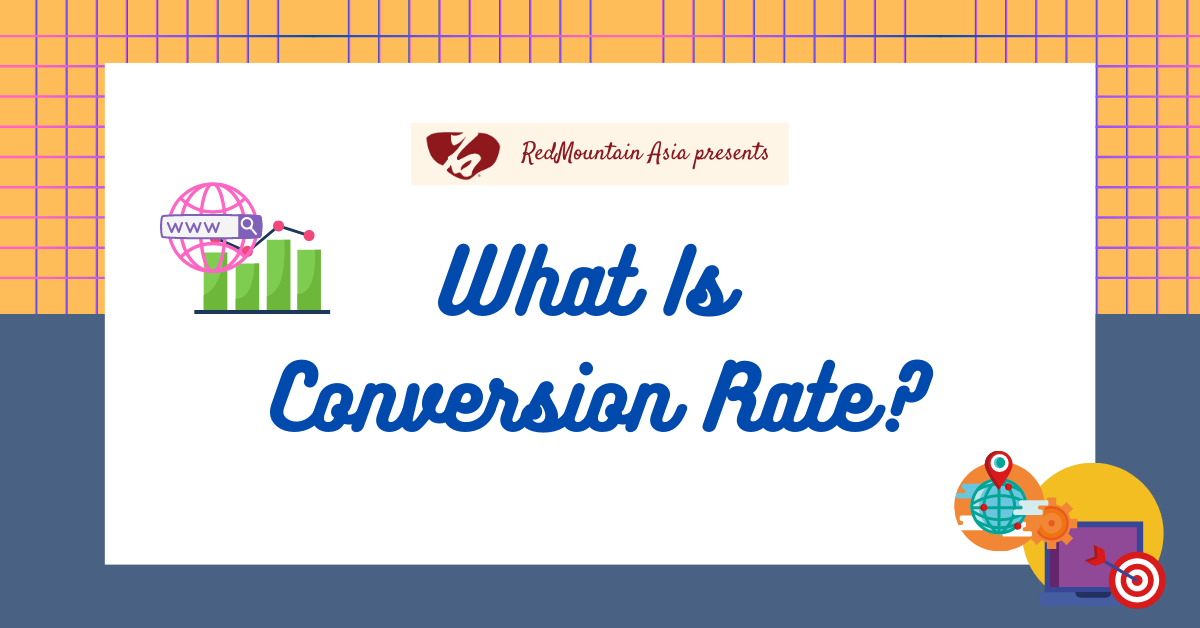The moment you step foot in the digital marketing field, you start hearing the term ‘conversion rate’ very often. Why? It is because regardless of the business nature, the digital marketing team always wants to ensure that something can be converted into something beneficial to the company after running an online advertisement or campaign.
In general, a conversion rate is defined by the number of conversions divided by the total number of visitors:
# of Conversion/Total number of Visitors
Most of the time, people assume that conversion rate solely means the number of online sales converted by website traffic. As a matter of fact, that is not always true. In this equation, the term ‘conversion’ doesn’t necessarily have to be about sales or revenue. Instead, it conveys a different meaning depending on the marketing goals.
For instance, conversion can be referred to the number of website visitors submitting a form or subscribing to an e-newsletter. It can also mean the number of leads registering for some events and services after visiting the website, or even the number of phone calls they make after seeing a certain marketing advertisement. In a nutshell, it can be related to any actions involved on the website.
To make you understand the equation better, here’s an example:
Let’s say 200 people visited your website yesterday after seeing your ads and 15 of them made a purchase, then the conversion rate would be 15 divided by 200, which is 0.075 or 75%, just simple as that.
15 Purchases/200 visitors = 0.075 or 7.5%
Why Is Conversion Rate So Important?

1) Conversion Is an Honest Assessment
Conversion rates are calculated by an equation, which is a good tool for people in digital marketing to analyze the business performance or marketing campaign effectiveness under a pretty fair and objective assessment.
As business goes online, one of the biggest pros is being able to get traceable and up-to-date reports about website traffic, engagements, and other actions happening on your website. They make it very convenient for those who want to compare the performance of various departments or digital marketing campaigns to find out the strongest and weakest suit.
2) Conversion Helps Improve Performance
As you use conversion rates to compare and assess the effectiveness of certain campaigns, you should know clearly what your expectation is. In other words, when the conversion rates don’t meet the target you expect, you make alterations and adjustments on the campaigns you run or even have a sense of which ineffective one to eliminate in order to lower the marketing cost. As a result, the numbers can doubtlessly help you improve your company’s performance as you use them as a marketing guideline of judgment.
Conversion Rate Optimization (CRO)
Now that we know why conversion rates are important to an online business, the next question is, how do we optimize them? If you are to define Conversion Rate Optimization, you would probably focus on increasing the percentage, which is not wrong! But there is certainly a better way to illustrate it: Conversion Rate Optimization is a practice of optimizing conversion rates by understanding visitors’ website behaviors, using different ‘hooks’ to increase engagements, and erasing all barriers possible.
From the definition above, you can see how it is not fully focusing on numbers, but rather the user’s experience. To encourage visitors to convert: whether to purchase an item from your website, or register for an event, you need to put yourself in their shoes and think like them.
Ways to Look at Conversion Rate Optimization
1) Quantitative Ways
Good analysis always contains numbers to support its findings. In order to optimize your website’s conversion rate, you need to have a good understanding of the ‘who’, ‘what’, ‘when’, and ‘how’.
Precisely, by using analytic tools like Google Analytics or some customer satisfaction (CSAT) tools, you can find out the ‘who’ – what are the demographics like, the ‘what’ – what time fo they usually visit and what are their activities like, the ‘when’ – at about what time do visitors browse your website and how long do they stay, and even the ‘how’ – how do they know your website, and how do they behave.
Besides, some tools also allow you to study website activities, like the number of scrolls or clicks, and movements on different landing pages, etc.
On top of that, you can also use technical tools to track down your website’s functionality by constantly checking whether your website has unnecessary codes, bugs, and broken links that stop people from visiting.
As a result, you can see that these quantitative methods assuredly allow you to understand your visitor’s behavior from an analytic way. More importantly, you can see what are some effective ‘hooks’ on your website that are able to persuade your audience to stay for longer, and even convert. Accordingly, you can adjust your website’s structure and layouts to cater to the audience’s needs.
2) Qualitative Ways
Apart from quantitative methods, you should also see conversion rate from a qualitative point of view. As we’ve mentioned before, in order to increase conversion rates, your main focus should be on your audience. To do so, you can utilize people methods to uncover the reasons behind your visitor’s actions.
One of the examples is by conducting satisfaction surveys and user testings to understand what your visitors think about your website structure, content, and design. Another way is by asking your audience directly, like asking them to fill out a feedback form or leaving a review after purchasing your product or service.
Through the ways mentioned above, you can get a more in-depth knowledge of what drives your audience to engage and what stops them from taking action.
Conclusion
In conclusion, conversion rates are certainly a reliable tool for companies to evaluate the efficiency of specific digital marketing advertisements or campaigns. Of course, many businesses focus on the conversion of online sales most of the time as it is the main source of revenue generation. That being said, a competent digital marketing team also focuses on other kinds of conversions that are related to customer experience and engagements.
If you are looking for one that can help you run campaigns and enhance your business’s online performance, RedMountain Asia would be your #1 choice. Not only do we do the math for you to make your life easier, but we also assure you to help you meet your marketing target with our considerate service. After all, our company’s tagline is ‘We’ve got your back.’




